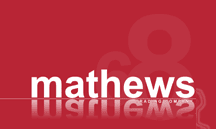Mathews
Trading Company
©
Mathews Trading Company |

Sewing Machine
A
machine designed to join pieces of fabric or leather by means of a lockstitch
or chain stitch. The lockstitch, which is used in most modern machines, is formed
from two threads and the chain stitch from a single thread.
History
The
first sewing machine was patented in 1790 by the British inventor Thomas Saint.
Saint's machine, which was designed to sew leather and canvas, used only a single
thread and formed a chain stitch. No needle was used; instead an awl was used
to pierce a hole through the material being sewed. Another mechanism placed the
thread over the hole, and then a needlelike rod with a forked point carried the
thread through to the underside of the work, where a hook caught the thread and
moved it forward for the next stitch. When the cycle was repeated, a second loop
was formed on the underside of the cloth with the first loop, thus forming a chain
and locking the stitch. Saint's machine, however, never progressed beyond the
patent model stage.
A French tailor, Barthélemy Thimonnier, built
the first practical sewing machine in 1829. It employed a hook-tipped needle that
was moved downward by a foot treadle and returned by a spring. Like Saint's machine,
it produced a chain stitch. When Thimonnier installed 80 of his machines in a
clothing factory the tailors of Paris wrecked them, and eventually he died bankrupt
in England.
The American inventor Walter Hunt devised the first lockstitch
machine about 1834. The machine, which employed both an eye-pointed needle and
an oscillating shuttle, was not patented at the time of its invention—so
when Hunt later attempted to obtain a patent, his claim was disallowed on grounds
of abandonment. Working independently, the American inventor Elias Howe devised
a machine that contained the same essential features as Hunt's and patented it
in 1846. Subsequently another American inventor, Isaac Merrit Singer, patented
a similar machine and was successfully sued by Howe for infringement of Howe's
patent. Singer, however, was instrumental in the pooling of various patents in
the sewing-machine field and in laying the groundwork for the mass production
of the machines.
Other important inventions in the field included the rotary
bobbin that was incorporated in 1850 into a machine patented by the American inventor
Allen Benjamin Wilson, and the intermittent four-motion feed for advancing the
material between stitches, which was part of the same patent. Singer devised the
presser foot, a spring-tension device for holding the material firmly against
the worktable, after the patenting of his first machine.
The earliest successful
sewing machines were powered by the turning of a hand crank. Later a foot-treadle
and crank arrangement was incorporated, enabling the operator to use both hands
in guiding the material under the needle. All modern sewing machines are now equipped
with electric motors activated by means of foot-operated or knee-operated controllers.
Operation
For
domestic sewing, either a straight-stitch or a zigzag sewing machine is used.
In straight stitching, the needle moves up and down, producing a straight line
of stitches; in zigzag stitching, the needle moves up and down and side to side,
resulting in a zigzag line of stitching. The zigzag machine is equipped for decorative
stitching, monogramming, overcasting, blindstitching, and sewing on buttons, making
buttonholes, and mending.
Most modern sewing machines employ two separate
threads to form a lockstitch. The upper thread is led through an eye formed near
the point of a needle. The under thread is carried on a bobbin and is linked or
locked to the upper thread by means of a rotary or horizontal motion of the bobbin.
In a typical machine employing a rotary bobbin, the sequence of operations is
as follows. The needle carrying the upper thread moves downward through the material
being sewed, and the thread is engaged above the eye of the needle by a hook on
the rim of the bobbin. As the bobbin turns, the upper thread is pulled out to
form a loop through which the under thread feeds. A tension device on the upper
part of the machine controls the size of the loop. As the needle withdraws, the
locked loop formed by the two threads is tightened by the pull of a lever take-up
device to form a stitch. In a machine employing a horizontal bobbin held in a
freely moving shuttle, the stitch formed is exactly the same. The shuttle moves
through the loop of thread as the needle comes down, and then the shuttle returns
to its original position as the needle moves up.
In addition to the large
number of machines available for home use, about 2,000 different types of industrial
sewing machines are designed for the manufacture of hats, shoes, and hosiery,
as well as for the sewing of garments. Modern machines, domestic and industrial,
are equipped with microprocessors to carry out automatic sequences of operations.
Sewing
Machine
People use sewing machines to design and create their own clothing
and household items. Advanced models are used for the mass-production of these
products in factories. In order to sew two pieces of fabric together, a machine
must first be threaded. Starting from a spool on the top right-hand side, thread
is passed through several guides to control its path and tension. It is eventually
pulled through a small hole in the bottom of the needle. Another thread comes
from a bobbin case beneath the feed dogs and sewing surface and is used with the
top thread to form stitches. Pieces of fabric are carefully pinned together, then
positioned near the needle. Finally, the presser foot is lowered to hold the fabric
firmly against the feed dogs, which are two small rows of metal teeth that move
the fabric forward at a uniform rate when a power pedal on the floor is depressed
and sewing begins.




